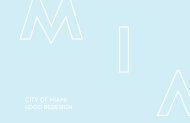Blouse Magazine
Create successful ePaper yourself
Turn your PDF publications into a flip-book with our unique Google optimized e-Paper software.
TECHNOLOGY
Blouse: Martha, your career path has had so many twists and turns that
I barely know where to start, so perhaps I should begin by asking you
what you’re up to at the moment?
Ladly: At the moment, and for some time now, I have been working in
academia. I worked in industry for a long time, but when the tech bubble
burst in 2001 I lost a big job that I had left the UK to take up. I was
back in Canada, I had two kids to support and I thought to myself, ‘You
know what? It’s time that I taught some of the things that I know.’ I had
already done some teaching in England at the University of the West of
England(UWE) and it was actually one of my friends, Bill Buxton, who
suggested that if I were to go back to where I had gone to school and
tell them that I was around, he was willing to bet they’d have something
they’d like me to teach.
Well sure enough, I walked in the door at OCAD University (formerly the
Ontario College of Art and Design) and was introduced to Steve Quinlan,
the Chair of Graphic Design, and Lenore Richards, the Dean, who offered
me a teaching job there and then. This was fantastic, and it helped that
I was talking to the right people! They were looking for someone with
ideas and experience to teach new media (which was still a very young
subject) and technology to design students. My industry perspective and
experience with Peter Gabriel’s Real World projects, and having helped
to set up the New Media program at UWE in the UK, were just what was
needed.
So you returned to your old art college to teach technology?
Yes, and since then I’ve been given the opportunity to design a new
graduate program with a group of fantastic colleagues at OCAD and the
CFC Media Lab called the Digital Futures Initiative. We were given the
green light by Sara Diamond, who’s been a long time colleague of mine
before she came here as President. She’s brought all sorts of fantastic
opportunities for technological innovation in the arts, sciences, research
and design to the University.
My colleagues Paula Gardner, David McIntosh, Geoffrey Shea and I
started the mobile experience lab, and it’s been highly successful at doing
all sorts of experimental research work. At this point I thought, “OK,
I’ve got a home here. I can teach what I know. I can do research in the
areas that I am interested in.”
What areas of research does your work at the mobile lab cover?
I run three research projects out of our lab that are funded in various
ways. One is working on mobile technology for elders, helping to scaffold
memory by allowing families and elders to collaboratively recreate
shared memories and engage in sharing family stories together. Another
is with the CIVDDD [Centre for Information Visualization and Data Driven
Design] which is looking at the sonification of data – how to make data
available through sound and how to search it through spoken word. We
are working with an amazing data set – 20 years of CBC News Network
video that will allow you to choose a day from the past then review and
search the news stories On This Day. The third is a project with Canadian
Women In Communication helping women in the TMT [Technology, Media
and Telecommunications] industries who are trying to move their careers
into the full potential of the digital realm. We’ve just completed three
in-person seminars in Toronto, Montreal and Vancouver, which we’re now
building into a series of online learning modules.
What kind of material do the seminars cover?
One of the sessions that we did in Montreal with digital artists, Mouna
Andraos and Skawennati Fragnito, was called “Good Enough: Iterative
Design And Digital Thinking”. It was all about the “Good Enough” design
methodology that’s used a lot in game and app design. You design and
put together something quickly that has all of the features you need but
without the bells and whistles. You put it onto a platform and then collaborate
with your users – the people who are going to be your audience
– and you figure out the improvements together.
That kind of “Good Enough” mentality can also be applied to how you
advance through different stages in your life. You just have to know
“enough” to know that you’ve got that grounding, that you’re open to
new ideas, and that you’re open to learning.
blouse.com/interview | 27






